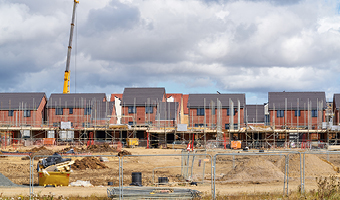The Government has belatedly released the long-awaited Levelling Up White Paper (LUWP), setting out twelve national levelling up missions. These missions reflect the medium-term ambitions of the Government, underpinning the expectations and plans of both the private sector and civil society. Whilst some missions are more precise than others, the general message is one of spreading opportunity more equally by 2030. The key to delivering this will be through devolution and empowerment of local leaders and communities.
The private sector has not gone unnoticed in this matrix, with a clear message of encouragement to work in partnership with the public sector to deliver these missions.
In this article, Dr Owen Hawe and Atul Joshi, from our Planning, Development & Regeneration team outline the key headlines from the LUWP and what the potential implications are for the property and planning industries.
Positive, loose and open to interpretation
The LUWP allows for opportunities to enhance environmental, social and governance (ESG) policies at the local level. The Government will set out an initial framework, which should then provide an opportunity for local authorities, stakeholders and communities to engage and direct positive initiatives at the local level. As the paper concludes, ‘this is a collective endeavour’ – we see the value in the Levelling Up agenda to bring back the old style grass roots, regional policy.
The elephant in the room is that, yes, the rhetoric in the LUWP is fantastic, it would be hard to find someone who doesn’t want a ‘healthier, greener, stronger, and fairer economy’ but we first need to start seeing this policy being applied with on-the-ground actions aiming to unlock investment.
We find ourselves in the epi-centre of the Levelling Up Agenda. Eight years have passed since the ‘Levelling Up’ phrase came to the fore, when the then Chancellor, George Osborne, announced the Northern Powerhouse Initiative. We now have eight more years to deliver the missions of the Levelling Up agenda, leaving many wondering if these are simply 12 Missions Impossible…
The lack of detail in the LUWP has also left us with a sense of dissatisfaction, as many important details will be delivered ‘in due course’. For the length of the paper, there simply isn’t enough to fully understand how these missions will be achieved at a local level. However, we must also acknowledge that the LUWP is perhaps more strategic – setting out the big picture – rather than the tactics of how success will be achieved.
Take a deeper dive into the detail
In this section, we take a closer look at the key topics emerging from the LUWP.
Devolution
Representing the biggest shift of power from Whitehall to local leaders in recent times, the LUWP will set out a complete systematic reform of how the government works, in order to better level-up the United Kingdom.
Planning
Anyone working in planning will be well aware of the slow process of adopting local plans. To address this, the LUWP states that ‘local plans will be made simpler and shorter’, work more efficiently, and give communities a greater voice. Councils and communities will also create new local design codes, helping to shape streets ‘as residents wish’. The LUWP continues with ‘empowering’ terminology throughout as it looks to shift the power to communities.
The housing crisis is still an ongoing issue, the LUWP responds on this front by stating that funding for housing will be focused on brownfield sites and away from London, unlocking £1.8bln investment to deliver up to 160,000 homes across England. New housing on brownfield sites could open further opportunities for regeneration, whilst improving well-being and urban living and positively contributing to “people everywhere living longer and more fulfilling lives, and benefitting from sustained rises in living standards.”
With last year’s Planning White Paper now likely being watered down from the radical reform initially implied, it is safe to say that although there are references in the LUWP to future planning reforms, much of the planning reform dialogue has been largely left open. On the plus side, it is positive that the Government is still indicating that these will happen but whether or not we will see anything before the next elections remains to be seen.
Town Centres
The Government will proactively identify and engage with 20 places in England that demonstrate strong local leadership and ambition and where the impact of existing investment can be maximised to catalyse economic transformation. The first of these will be Sheffield and Wolverhampton. In England, the Government will refocus Homes England so that it uses its extensive statutory powers to partner with local leaders to unlock barriers and drive forward regeneration.’
A key ‘mission’ is for “Pride in Place” with the aim that by 2030, people’s satisfaction with their town centre and engagement in local culture and community, will have risen in every area of the UK, with the gap between top performing and other areas closing.
To aid with this, 68 local authorities are to receive expert support from the High Street Task Force including Southend-on-Sea, Somerset West and Taunton, Rossendale and Dudley. Delivery to these local authorities will be staggered, starting from summer 2022 until the end of the programme in 2024. Furthermore, the Government will explore further measures to revitalise high streets including “ways to incentivise landlords to fill vacant units. For instance, powers for local authorities to require landlords to rent out long-term vacant properties to prospective tenants”. We will wait to see how this is put into practice considering landlords will always seek to generate income from their properties.
The Government will also enhance compulsory purchase powers to support town centre regeneration; provide further support for re-using brownfield land for development; set a more positive approach to employment land in national policy to support the provision of jobs; and increase engagement with infrastructure providers in plan making to bolster productivity.
Part of the policy programme relates to high street rejuvenation, the High Street Strategy making it easier for converting empty shops into new uses, such as homes; rights to allow al fresco dining making streets safer and cleaner. In continuation to the loosening of planning restrictions, the LUWP states that “the UK Government will bring forward further measures to make high streets and town centres the thriving hearts of communities again.”
Regeneration and Funding
The LUWP recognises that the preparation of bids for government funding can be substantial as they must include complete business cases and require a lot of resourcing which may not even result in any funding, against tight timescales. Hence, the Government intends to streamline the funding landscape and help local stakeholders more on how to navigate funding opportunities. Consequently, the Government intends to streamline the funding landscape and help local stakeholders more on how to navigate funding opportunities. This review is guided by four principles:
- reducing the unnecessary proliferation of individual funding pots with varied delivery approaches;
- streamlining bidding, and supporting greater alignment between revenue and capital sources;
- ensuring places have robust ongoing monitoring and evaluation plans for the impact and delivery of investments and spending; and
- tailoring investment and delivery to the local institutional landscape of each nation of the UK.
The criteria for qualifying for future funds still appears to be unclear. It is our opinion that funding could be more restrictive on back of the economic cost resulting from the Covid-19 crisis amongst other fiscal uncertainties.
Health and Well-Being
It is hugely positive that health and well-being span across two Missions, with the aim of narrowing the Health Life Expectancy (HLE) and improving overall well-being by 2030. Having a health outcome as a priority for the UK Government demonstrates just how important having a healthier society is. Health remains a hot topic in the world of planning and development and this is a good reminder that it’s at the forefront of the Levelling Up agenda. Having a health outcome as a priority for the UK Government demonstrates just how important having a healthier society is, in all respects. Furthermore, health has been implied to become more devolved.
The paper acknowledges that a society in good health contributes not only to the economy but also ensuring that everyone, wherever they live, can enjoy fulfilling, happy and productive lives. The Department of Health and Social Care (DHSC) are preparing a White Paper designed to tackle health disparities, and it will be interesting to see if the built environment will be included in this.
Culture
Culture has also been included as part of restoring a sense of community, local pride and belonging. There is discourse on culture-led regeneration and transforming the landscape for arts, culture and heritage by “significantly increasing cultural investment outside London”. In fact, 100% of the additional funding for Arts Council England agreed at 2021 Spending Review (SR21) to support culture and creativity will be for outside London, including a £2bn Culture Recovery Fund helping museums, theatres, cinemas and heritage organisations survive the pandemic.
Employment
The LUWP promises to “set a more positive approach to employment land in national policy to support the provision of jobs; and increase engagement with infrastructure providers in plan making to bolster productivity”. This is a welcomed announcement for employment land to be on a more level footing with housing land and one that is urgently needed if the UK is to keep up productively levels in line with other advanced economies.
Energy
Decarbonisation and the ‘transition to net zero’ is also a great soundbite although there’s little detail on a strategic plan for actually implementing this and how this ties in with previous announcements to reduce carbon emissions by 68% by 2030 (compared to 1990) and 78% by 2035.
Get in touch
If you have any questions on the Levelling Up White Paper (LUWP) and what it may mean for you, please contact us on the details below.
We will also be releasing a series of further viewpoints on details relating to the LUWP from a regional, regeneration, town centre, residential, employment, Compulsory Purchase and infrastructure perspective – watch this space.
Get in touch


Email me direct
To:
REGISTER FOR UPDATES
Get the latest insight, event invites and commercial properties by email







